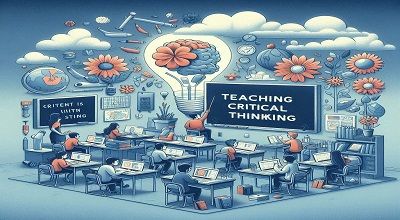Teaching Critical Thinking Starts With The Student
Teaching Critical Thinking Starts With The Student: Teaching critical thinking is an essential aspect of education, and it indeed begins with the student. Critical thinking involves the ability to analyze, evaluate, and synthesize information to make reasoned decisions. Here are some key principles to consider when fostering critical thinking skills in students:
Create a Positive Learning Environment:
- Foster an atmosphere that encourages open-mindedness and intellectual curiosity.
- Promote a safe space where students feel comfortable expressing their thoughts and challenging ideas.
Encourage Questioning:
- Teach students to ask questions about the information they encounter.
- Encourage curiosity and a desire to understand the underlying reasons behind concepts.
Develop analytical skills:
- Teach students how to break down complex problems into smaller components.
- Emphasize the importance of examining evidence and considering multiple perspectives.
Emphasize Reflection:
- Incorporate reflective practices into assignments, encouraging students to think critically about their thought processes and decision-making.
Promote active engagement.
- Incorporate interactive learning methods, such as discussions, debates, and case studies, to engage students actively with course material.
- Provide real-world examples to help students connect theoretical concepts to practical applications.
Challenge Assumptions:
- Encourage students to question assumptions, both their own and those presented in course materials.
- Teach them to recognize and challenge biases that may influence their thinking.
Develop Information Literacy:
- Teach students how to evaluate the credibility and reliability of sources.
- Emphasize the importance of cross-referencing information from multiple sources.
Problem-Solving Exercises:
- Present real-world problems that require critical thinking and problem-solving skills.
- Encourage students to collaborate and discuss potential solutions.
Provide Constructive Feedback:
- Offer feedback that focuses on the process of thinking rather than just the final answer.
- Help students understand how they arrived at their conclusions and whether there are alternative approaches.
Integrate Critical Thinking into the Curriculum:
- Design assignments and assessments that require critical thinking skills.
- Integrate critical thinking into lesson plans across various subjects and disciplines.
Model Critical Thinking:
- Demonstrate critical thinking in your teaching practices.
- Share your thought processes and decision-making strategies with students.
Finally, Teaching Critical Thinking Starts With The Student is a skill that can be developed over time, and it’s important to provide ongoing support and guidance as students progress in their education. By fostering a culture of critical thinking, educators empower students to become independent and analytical thinkers who can navigate a complex world.
